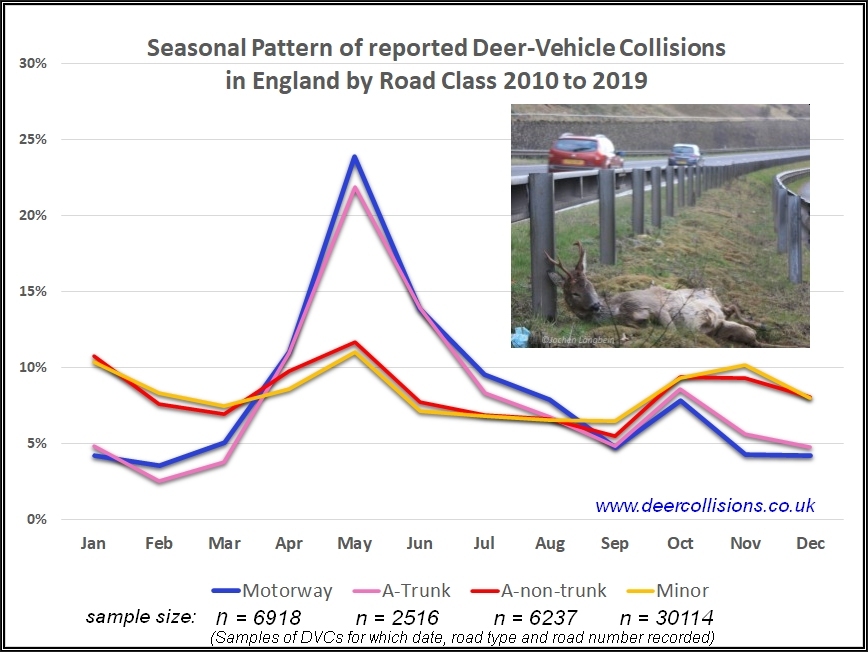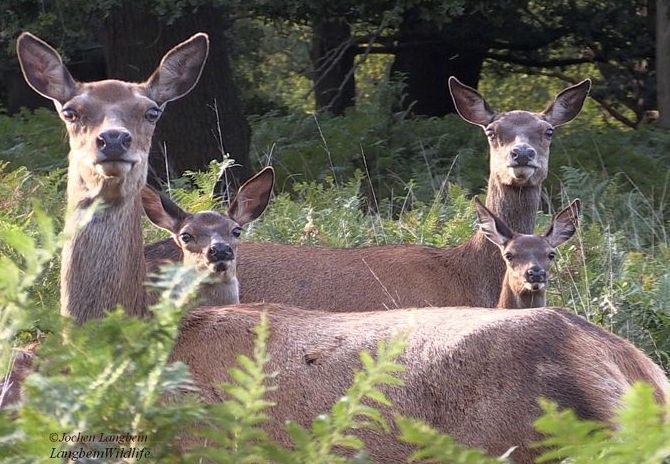MAY is the PEAK MONTH for deer road casualties and related vehicle collisions across Great Britain. Over 10,000 deer are likely to be hit in May alone – that’s close to twice as many as in any other single month and makes up near 15% of the annual toll of between 60,000 to 74,000 GB deer road casualties.

This peak in Deer Vehicle Collisions (DVCs) is, as shown in the graph below, far less pronounced on minor roads, that deer may cross on a daily basis when moving from cover to feeding areas, and which of course in general carry relatively modest traffic volumes. For motorways and major A-class trunk roads England, however, the spring peak in DVCs from April through to June makes up over 50% of the annual DVC toll on these road types (see Graph). (The pattern in Scotland is closely similar, although there motorways make up a much lower proportion of the strategic trunk network).
In April and May young deer coming up to one year old (especially the territorial roe deer, which remain our most common and widespread UK deer species) will tend to be pushed out of their natal ranges, and as they disperse in search for new home ranges are much more likely to attempt to cross the more substantial barriers presented by dual carriageways and motorways.

Aside from dispersing animals, adult females too will increasingly cross roads during May on their way to more secluded areas of cover that they may seek out for giving birth – or often with new fawns at heel as they return. Oddly enough, even though road side verges may seem rather noisy places to us, as vegetation grows denser during spring they become increasingly attractive for deer to settle within, because scrub and linear strips of woodland alongside major roads and even on roundabouts will often be relatively undisturbed by pedestrians and not least importantly dog walkers.
A further, but overall smaller peak in DVCs occurs in autumn, when our three largest deer species (red, fallow and sika) will be on the move again to and from their rutting areas. This second peak in deer accidents from mid-October through into early November tends to be most prominent in: A) Large community forests where fallow deer predominate – including Cannock Chase, Ashdown Forest, The Forest of Dean, Epping Forest, Haldon Hill, Ashridge Forest, The New Forest and also The Royal Parks of Richmond and Bushy; and B) throughout those regions of the country with high concentrations of wild red deer such as The Scottish Highlands, Grizedale Forest, and Exmoor and The Quantock Hills.
In addition to late autumn being the rutting season for the large deer species, when adult males will often chase blindly across roads in pursuits of females or rival males, the shorter day lengths bring rush hour traffic periods in line with the peak dawn and dusk activity times of all our deer species deer, adding further to an increase in deer collision risk.
Whatever the season, one of the most important things for drivers to be aware of is that when you see one deer cross there is a high chance another will be following behind. Have a listen to the deer in the video clip above who will tell you more about this ; and please share it widely to help raise driver awareness of the very real risk of deer vehicle collisions – especially but not only – during the months of May and Oct/November. (If unable to view Youtube , a Facebook version of the clip is here: https://www.facebook.com/LangbeinWildlife/videos/1720421378210744/ )
Click here for more tips on avoiding deer collisions or what to do if you are unfortunate enough to be involved in one.
County by County Maps of the recorded distribution of deer-vehicle collisions in England & Wales based on our research are available here . And to help map further DVC hotspots please do log the dates and locations of any deer road casualties you may see on this on-line reporting form.
See also : Video Vlog “How Red Deer Cross Roads”




One Comment Add yours